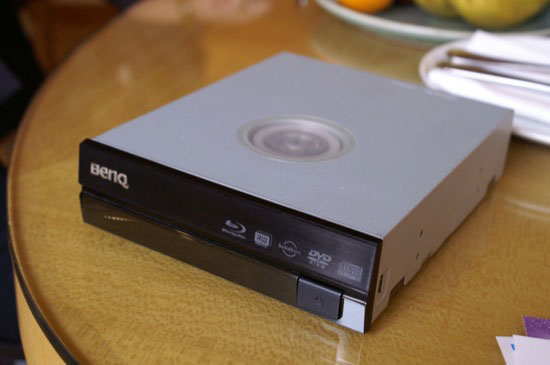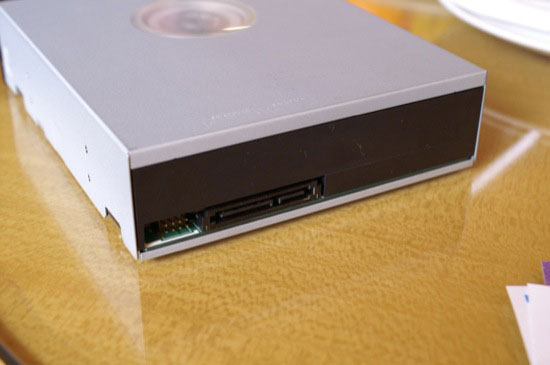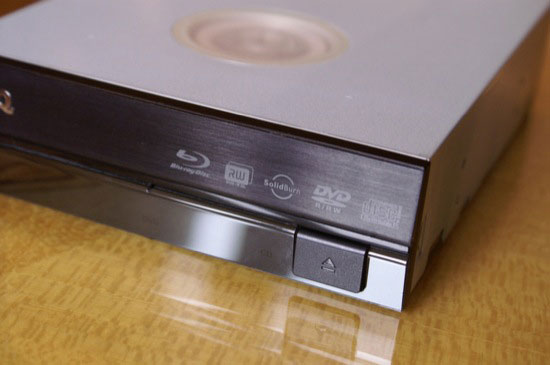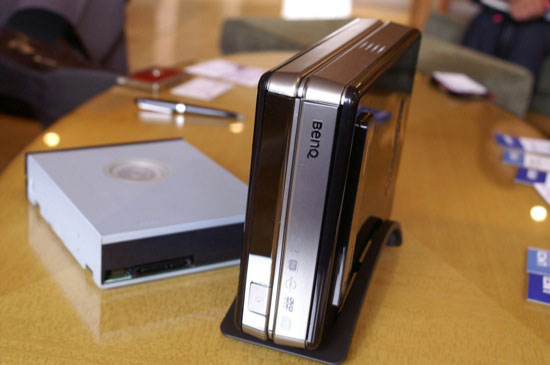Computex 2006: 300W GPUs, Conroe, HDMI Video Cards and Lots of Motherboards
by Anand Lal Shimpi on June 5, 2006 10:24 PM EST- Posted in
- Trade Shows
BenQ: Status of Blu-ray and SATA Optical Drives
We talked at great length with BenQ about the current lack of Serial ATA optical drives. While SATA optical drives don’t offer any real performance advantage over PATA drives, there are other factors that are driving our demand for and interest in the units. Intel’s new I/O Controller Hub used in the 965 (Broadwater) chipsets, ICH8, doesn’t natively support any PATA ports; motherboard manufacturers have to resort to a 3rd party controller to offer one PATA port. It’s clear that Intel wants to be rid of PATA, and with 6 - 8 SATA ports on new motherboards these days the time to transition entirely to SATA is now.
Unfortunately, as BenQ tells us, the same desire to transition to SATA doesn’t exist with the Tier 1 OEMs that are building systems using these optical drives. Apparently there are still a number of compatibility issues with the default Windows driver and many SATA optical drives, which has made the big OEMs wary of moving away from tried and true PATA drives. With very little OEM pressure to transition to SATA optical drives, manufacturers like BenQ have no reason to push for a quicker move to SATA.
BenQ said to expect less than 5% of its drive shipments by the end of this year to be SATA; by the middle of next year that number will thankfully grow to 25%.
With DVD readers and recorders quickly dropping to commodity price levels, the new focus of optical drive makers is on Blu-ray and HD-DVD. BenQ is exclusively producing Blu-ray drives and its representatives showed us the first two Blu-ray drives that will debut later this year. The BW1000 is offered in both an internal and an external variety, both featuring a 2X read/write speed for Blu-ray media. Dual layer Blu-ray media will be written to at 1X.
The drives also feature a LED indicator telling you what sort of media you’ve got in the drive (e.g. Blu-ray or DVD). The internal drive will carry a price tag of around $700 when it debuts in July. The Optical Pickup Unit in a Blu-ray drive can cost around 20x that of the OPU in a DVD drive, which contributes to the incredibly high cost.
BenQ stated that you may be able to upgrade these 2X drives to 4X drives with a firmware update later on, but it’s too early to tell for sure. The first native 4X Blu-ray drives from BenQ will arrive in Q1 of next year.















61 Comments
View All Comments
ceefka - Tuesday, June 6, 2006 - link
Just when Intel has attractive numbers on power consumption and also AMD aims again for lower numbers these GPUs negate all their effort and have you on the look out for an even bigger PSU or an additional PSU. How can ATI or NVIDIA justify this? I'd like a good reason.phusg - Tuesday, June 6, 2006 - link
I think you've already given the only reason (CPU's using less). I won't call it a 'good' reason, but all the same.sri2000 - Tuesday, June 6, 2006 - link
When I read that line about 1000-1200 watt PSU's, all I could think of was Doc Brown in Back to the Future yelling "1.21 Gigawatts!?!"... (yeah I know - kilowatt != gigawatt... but still).Griswold - Tuesday, June 6, 2006 - link
Who knows, maybe ATI/Nvidia bundle plutonium batteries (as seen in deep space probes) with their cards in the future? Not only to feed the cards but mainly to power your cooling equipment...segagenesis - Tuesday, June 6, 2006 - link
Exactly my first thought. The concept of a seperate external supply for a graphics card is already ludicrous to me, if this becomes standard then I would hate to see future progression from there. Does anyone remember the Taco Town SNL skit? I desire better video as much as anyone else, but I draw the line when I need a nuclear power station to run it. ATI/nVidia must have forgotten that electricity DOES cost money.Needless to say... impressive Conroe boards, for a premium.
Stele - Tuesday, June 6, 2006 - link
All in all an excellent article, good coverage and of course lovely photos :PThe Asus Pluto board is interesting indeed, especially the audio riser card. By the way, anyone noticed that the riser card is nicknamed Charon? For the uninitiated, Pluto was the Greek god of the Underworld, separated from the living world by the river Styx. Charon was the boatman who ferried the dead across that river to Pluto's domain. The two have hence been generally closely associated with one another. In astronomy, Pluto's moon is also named Charon, for the same reason. Nice bit of humour on Asus' side :P
punko - Tuesday, June 6, 2006 - link
Actually, Pluto is the Roman name for the Greek God Hades. Charon was indeed the ferryman of the Underworld, but the river wasn't Styx, but Acheron. I believe that there were four famous rivers in the Underworld, Lethe was another, but I can't remember the fourth.Stele - Tuesday, June 6, 2006 - link
It is another Greek name for Hades (from Greek ????t??, Plouton), but it was adopted by and hence much more commonly associated with Roman mythology.
Oh heh! Styx was the popular misconception... forgot about it. Thanks for correcting me! There were five rivers of Hades: Acheron (the river of sorrow), Cocytus (lamentation), Phlegethon (fire), Styx (hate) and... Lethe (forgetfulness). I guess that explains why you remember Lethe but forgot the others! ;)
DigitalFreak - Tuesday, June 6, 2006 - link
Didn't really see anything new here.Audio on a riser card - DFI has been doing it for awhile now.
Lighting around the I/O shield - Been done before.
Debug code readout - Been on numerous boards for quite some time. Asus just made it viewable from outside the case.
Stele - Tuesday, June 6, 2006 - link
No, I wasn't saying that anything was new in the industry, but new at least to Asus. IMHO the concept motherboard was an interesting exhibit, even if it isn't the only one of its kind.More to the point, what's noteworthy is that Asus - along with other manufacturers as well, hopefully - is considering following DFI's Karajan module concept. That can only be a good thing, as long as the manufacturers sincerely mean to improve noise immunity and not just throw it in as a gimmick to charge a premium for.
As for the other ideas... interesting but not terribly unique, as you've already pointed out.